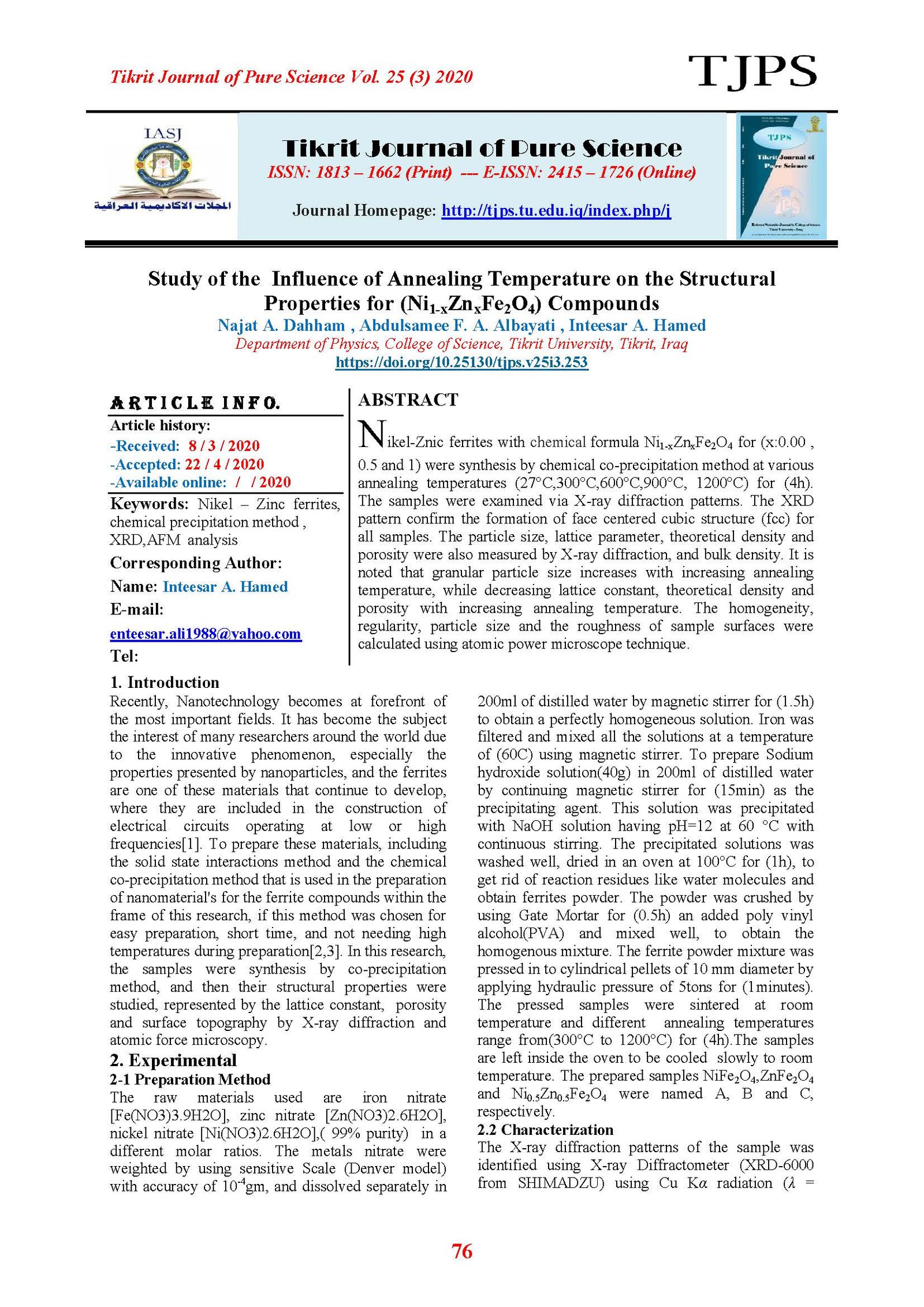Study of the Influence of Annealing Temperature on the Structural Properties for (Ni1-xZnxFe2O4) Compounds
Main Article Content
Abstract
Nikel-Znic ferrites with chemical formula Ni1-xZnxFe2O4 for (x:0.00 , 0.5 and 1) were synthesis by chemical co-precipitation method at various annealing temperatures (27°C,300°C,600°C,900°C, 1200°C) for (4h). The samples were examined via X-ray diffraction patterns. The XRD pattern confirm the formation of face centered cubic structure (fcc) for all samples. The particle size, lattice parameter, theoretical density and porosity were also measured by X-ray diffraction, and bulk density. It is noted that granular particle size increases with increasing annealing temperature, while decreasing lattice constant, theoretical density and porosity with increasing annealing temperature. The homogeneity, regularity, particle size and the roughness of sample surfaces were calculated using atomic power microscope technique.
Article Details

This work is licensed under a Creative Commons Attribution 4.0 International License.
Tikrit Journal of Pure Science is licensed under the Creative Commons Attribution 4.0 International License, which allows users to copy, create extracts, abstracts, and new works from the article, alter and revise the article, and make commercial use of the article (including reuse and/or resale of the article by commercial entities), provided the user gives appropriate credit (with a link to the formal publication through the relevant DOI), provides a link to the license, indicates if changes were made, and the licensor is not represented as endorsing the use made of the work. The authors hold the copyright for their published work on the Tikrit J. Pure Sci. website, while Tikrit J. Pure Sci. is responsible for appreciate citation of their work, which is released under CC-BY-4.0, enabling the unrestricted use, distribution, and reproduction of an article in any medium, provided that the original work is properly cited.
References
[1] Bowen, H.K.; Human, D.R. and Gingery, W. (1976).Introduction to ceramics. 2nd edn. John Wiley and Sons , New York.
[2] Dunlap, R. A.; Alghamdi, A.; O’Brien, J. W.and Penney, S. J. (2004). A Mössbauer effect investigation of superparamagnetic behavior in ball milled Mn–Zn ferrites. Journal of Alloys and Compounds, 365(1): 84-88.
[3] Allouche, J. (2013). Synthesis of Organic and Bioorganic Nanoparticles : An Overview of the Preparation Methods. Nanomaterials: a danger or a promise, Springer-Verlag London:27-74pp.
[4] Banerjee, M.;Verma, N. and Prasad, R. (2007). Structural and catalytic properties of Zn1-x CuxFe 2O4 nanoparticles. Journal of materials science, 42(5):1833-1837.
[5] Jacob, J.; Khadar, M. A.; Lonappan, A.and Mathew, K. (2008). Microwave dielectric properties of nanostructured nickel ferrite. Bulletin of Materials Science, 31(6): 847-851.
[6] Batoo, K. M.and Ansari, M. S. (2012). Low temperature - fired Ni-Cu-Zn ferrite nanoparticles through auto-combustion method for multilayer chip inductor applications. Nanoscale research letters, 7(1): 112.
[7] Shinde, T. J.; Gadkari, A. B.and Vasambekar, P. N. (2008). DC resistivity of Ni–Zn ferrites prepared by oxalate precipitation method. Materials Chemistry and Physics, 111(1): 87-91.
[8] Cullity, B. D. (1978). Elements of x-ray diffraction. Reading, MA: Addison - Wesley Publishing Company, Inc.
[9] Sultan, N. T. (2011). Increased Porosity and Their Effect on The Density and Hardness Value of (Ni—Cu) Alloy. Engineering and Technology Journal, 29(1):66-74.
[10] Kurian, M. and Nair, D. S. (2016). Effect of preparation conditions on Nickel Zinc Ferrite nanoparticles: A comparison between sol–gel auto combustion and co-precipitation methods. Journal of Saudi Chemical Society, 20(1):S517-S522.
[11] Suresh, S. (2013). Synthesis, structural and dielectric properties of zinc sulfide nanoparticles. International Journal of Physical Sciences, 8(21):1121-1127.
[12] Sileo, E. E.; Rotelo, R. and Jacobo, S. E. (2002). Nickel zinc ferrites prepared by the citrate precursor method. Physica B: Condensed Matter, 320(1-4): 257-260.
[13] Zi, Z. et.al. (2013). Size Effects on Magnetic Properties of Ni0.5Zn0.5 Fe2O4 Prepared by Sol-Gel Method. Advances in Materials Science and Engineering,2013:1-10.
[14] Sutka, A.; Gross, K. A.; Mezinskis, G.; Bebris, G. and Knite, M. (2011). The effect of heating conditions on the properties of nano - and microstructured Ni–Zn ferrite. Physica Scripta, 83(2):025601.
[15] Ognjanović, M. et.al. (2019). Bifunctional (Zn,Fe)3O4 nanoparticles: Tuning their efficiency for potential application in reagentless glucose biosensors and magnetic hyperthermia. Journal of Alloys and Compounds,777: 454-462.
[16] Bera, J. and Roy, P. K. (2005). Effect of grain size on electromagnetic properties of Ni0.7Zn0.3Fe2O4 ferrite. Physica B: Condensed Matter, 363(1): 128-132.
[17] Jawad, N.A. (2018). Study of Some Physical Properties for Nano Chemically Prepared Compound of (ZnxFex-3O4), M.Sc. thesis, Tikrit University, Tikrit, Iraq.
[18] Paramesh, D.; Kumar, K. and Reddy, P. (2016). Influence of nickel addition on structural and magnetic properties of aluminium substituted Ni-Zn ferrite nanoparticles. Processing and Application of Ceramics, 10(3):161-167.
[19] Babu, K.V.; Chandra, M. R.; Kumar, G. V. S. and Jagadeesh, K. (2017). Effect of cobalt substitution on structural, electrical and magnetic properties of NiFe2O4. Processing and Application of Ceramics,11(1):60-66.
